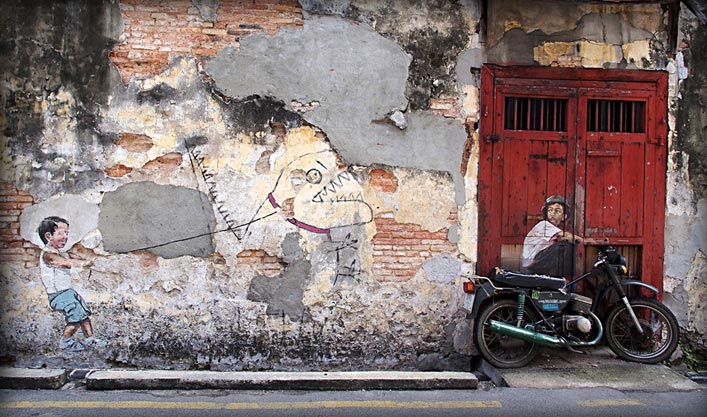Cashing in on Creativity
Young, fresh, radical and more often than not totally illegal, street art has taken our hearts and minds by storm. Now way beyond Banksy (also on Artsy.net), hundreds of internationally known artists regularly enhance the urban landscapes of cities such as Bangkok, Berlin, Bethlehem, Bogota, Bristol, Buenos Aires, Cape Town, Dublin, Gdansk, Istanbul, LA, Lisbon, London, Melbourne, Mexico City, Montreal, Moscow, NY, Paris, Philadelphia, Prague, Quintanar de la Orden, Rio, Santiago, Sao Paulo and Taipei, just to name the small ones. Our wonderful Penang deserves one of the higher rankings as street art is live and kicking in Unesco World Heritage Site Georgetown.
With one stunningly original mural around practically every corner, you have great chances of capturing your next perfect facebook profile pic (Penang was ranked by Time magazine to be one of the world’s 10 selfie capitals), but unless you are interested enough in finding out more about the origins of your newest Like-generator, this will be the end of your brief love affair as the artist themselves are rarely credited or mentioned.
Everyone likes something for free. And with something so unquantifiable as art that is not traditionally established (we’re not talking Monet or Damien Hirst here), it is more often than not up to the artists to follow their passion, beyond all the odds, keep their heads above water whilst they experiment, learn, develop and perfect their skills over years of hard work and financially supporting themselves through other means, only to then find someone willing to allow them to express themselves creatively on a piece of urban canvass or risk an ASBO (that’s ‘anti-social behaviour order’ to you non-Brits) or charges of vandalism if they go out in the dead of night and paint anyway.
Considering the working conditions and risks (from financial ruin to a criminal record) involved, it is quite honourable that there are people in this world willing to stick with their visions for the love of their art. As we all know, getting paid for creative work is hard enough when you’re in the corporate industry, but getting paid to completely free reign and –shock, horror – without ADVERTISING anything in particular is near impossible. Surely, if it’s not commercial, there is no real term value in it. No quantifiable cash profit attached. Therefore, why would any sane person invest in a piece of street art?
First of all, dear reader, if we have to remind you that there is more to this world than money, then we live in a bit of a sad place in time. Artistic expression can create a whole new world in a previously unloved place. It can turn a boring part of town into a trendy hideout, an abandoned park into somewhere people enjoy frequently spending time, turn a rough neighbourhood aspirational, inspire hope, humour and opportunity for communities in dire conditions.
And before you start waving a balance sheet at us, more than just human payoff, street art pays off in financial terms too. Penang’s tourism industry has vastly benefitted from attracting a whole new and young demographic following the explosive interest created by Ernest Zacharevic’s paintings around Armenia Street – most famously the two kids on a bicycle.
Originally commissioned by Mirrors (an art project from the 2012 Georgetown Festival), his mural was selected by the Guardian as one of the world’s best pieces of street art in 2013. And it’s only one of 6 fantastic pieces in the series, and Ernest is only one of many artists who have made it their mission to paint Georgetown in their spare time, for the love of their craft. Kenji Chai, Cloakwork, Drewfunk, Katun, Julia Volchkova and Siek as well as Natthapon Muangkliang, Louise Low, and Tang Yeok Khang of the 101 Lost Kittens project are also incredibly talented people who will make you sit up and take notice. And if you are fortunate enough to come to this wonderful place, check out the Hin Bus Depot, which hosts regular exhibitions, events and film screenings.
Despite the financial payoff, artists are still struggling. Interestingly it is now the same people who wouldn’t dream of investing in something as un-commercial as street art, who produce the endless supply of t-shirts, post cards, notebooks and re-prints featuring (and often not crediting) the artists’ work, making good cash off tourists willing to pay extra for that cute but ironically somewhat useless souvenir.
But there is no point in being bitter. After meeting up with Ernest (we have good mutual friend, who knew?), manager Gabi, Ronaldas and the Ipoh film crew, we strolled through the beautiful street light lit lanes of Georgetown. We heard all about his paintings being replicated in different parts of the world, of merchandise and re-prints being peddled for profit without credit or royalties but also about locals lovingly repairing damaged parts of the murals, or touching up faded paint. And if someone’s going to all the trouble to re-create your work, there must be something in it.
When we happened to walk past the mural of a boy on a motorbike, glancing fearfully over his shoulder, we heard the wonderful story of how someone had painted a child’s pencil rendering of a fierce dinosaur chasing the motorbike, and how everyone had been up in arms about the mural having been ‘vandalised’. Ernest’s response was to paint another boy behind the dinosaur, holding him by a dog lead. Talk about a positive spin.

Ernest’s years of hard work are now paying off, he has commissions by major brands including Samsung and Allianz, but there are plenty of artists whose talents still go un-credited or even unnoticed. Next time you’re out marvelling at a mural, take a bit of time to find out who made it, what their story is and what they are up to now.
Promote their work and credit them if you love it. Support it where you can. If you are in a position to commission artists, take the leap and pay them. And if not, take time in researching them a bit. Often, the more context you discover, the more alive the piece of art will be. Just like our little bit of insight about Ernest’s dinosaur, you’ll be part of the little stories behind the postcards.
